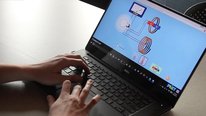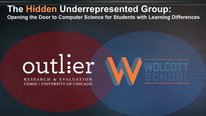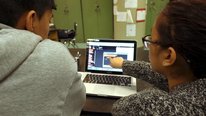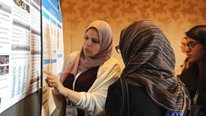
STEPHANIE LUDI
Rochester Institute of Technology, TERC
Inclusive Exploring Computer Science for Visually Impaired Students
NSF Awards: 1240809
The video will present an overview of our Inclusive Exploring Computer Science project that supports middle and high school students with visual impairments.
Inclusive Exploring Computer Science for Visually Impaired Students
NSF Awards: 1240809
The video will present an overview of our Inclusive Exploring Computer Science project that supports middle and high school students with visual impairments.
-
 Quality Education is Accessible
Quality Education is Accessible
Brianna Blaser
-
 Accessible PhET Simulations
Accessible PhET Simulations
Emily Moore
-
 Including Students with Learning Differences in CS
Including Students with Learning Differences in CS
Sarah Wille
-
 Combating Chicago’s Computing Deserts
Combating Chicago’s Computing Deserts
Ugochi Acholonu
-
 Beauty and Joy of Computing in NYC
Beauty and Joy of Computing in NYC
Mary Fries
-
 CRA-Women: Celebrating 25 years of Mentoring
CRA-Women: Celebrating 25 years of Mentoring
A.J. Brush
6084 Views
Public Discussion
Continue the discussion of this presentation on the Multiplex. Go to Multiplex
6084 Views
Related videos you might be interested in...
-
 Quality Education is Accessible
Quality Education is Accessible
Brianna Blaser
-
 Accessible PhET Simulations
Accessible PhET Simulations
Emily Moore
-
 Including Students with Learning Differences in CS
Including Students with Learning Differences in CS
Sarah Wille
-
 Combating Chicago’s Computing Deserts
Combating Chicago’s Computing Deserts
Ugochi Acholonu
-
 Beauty and Joy of Computing in NYC
Beauty and Joy of Computing in NYC
Mary Fries
-
 CRA-Women: Celebrating 25 years of Mentoring
CRA-Women: Celebrating 25 years of Mentoring
A.J. Brush
Stephanie Ludi
Hello everyone!
While there are many facets to the IECS project, I designed the video to highlight the Exploring Computer Science tools and strategies used that are meant to reach students with visual impairments. Sometimes the tools are software-based and other times the accommodations are not technical but speak to the creativity needed to provide for inclusion.
Katie Rich
Curriculum Developer
Hi Stephanie,
It’s so interesting to watch students make sense of something by feel. I’ve often thought to myself that one of the hardest things to conceptualize about programming is that all the necessary information and instructions have to be communicated to the machine without the benefit of visual aids.
You mentioned that the partner robotics activities often led students to come up with creative ways to describe the parts and how they fit together. Could you give a couple examples of that? And do you think there is any relationship between developing that skill (that is, developing our ability to communicate with other people without visual aids) and learning to program?
I’m often struck by the power of designing for accessibility. Often strategies that are intended for a particular group end up having potential benefits for everyone. This is a great example of that.
Stephanie Ludi
Thank you.
It was interesting to watch the students describe the Lego Mindstorms parts without using color. For example there are several connectors that have subtle textural differences, the students would ask for rods, small connectors, etc. and also describe something about them such as ‘there is a notch near the end’ or ‘it is 3 holes long’.
You pose an interesting question about being able this ability to communicate and programming. As we work with our next cohort, it will be interesting to see if similar communication arises I or if the communication was unique to last year’s cohort.
Irene Lee
Research Scientist
Thank you for sharing your work. Could you tell me more about how you plan to reach more people? Have you encountered challenges in sharing activities and lessons?
Stephanie Ludi
After we get a bit more feedback, we intend to share the materials and tools online so that teachers can easily access the curriculum and tools. We will send out the link to listsevers for teachers as well as to share the link as a resource to the main Exploring CS folks to share with their teachers and partners.
So far the biggest challenge has been sharing our JBrick software in a manner that is easy to set up. We are workin on that.
Brian Harvey
This project is of special interest to me because I’m part of one of several CS Principles curricula using visual, blocks-based programmng languages. (Ours is the Beauty and Joy of Computing.) Visually impaired students are not so well served by a visual programming language! We are trying to develop accommodations for our language (Snap!), but we have a long way to go, so I’m hoping you’ll have good ideas for us.
Stephanie Ludi
I would love to talk to you offline as I am doing work with Blockly in this very area! It is an area with high impact as so many outreach programs and curricula use block based languages. Also features to make them accessible to the visually impaired have the potential to help other groups of students.
Evan Korth
Clinical Professor
Really fascinating.
To Katie’s point on verbal communication: My office neighbor at NYU for a few year was a blind PhD student. He is a super smart guy. His name is Nektarios Paisios and he is at google working on Chrome accessibility. I used to be amazed how he could understand algorithms primarily by listening and reading without the benefit of figures and diagrams. I wonder if he would be a good resource for your project.
Stephanie Ludi
This is an interesting area of study actually, as I have a Ph.D. Student who surveyed 69 developers who are blind, and then interviewed and observed 14 of them (the observation was in programming tasks). As he progresses through his work, along with this IECS project in progress, it is interesting to see what common skills exist between these 2 groups as well as what gaps or issues exist with students who are novices.
Thank you for letting me know about about your friend. I will try to reach out to him.
Barbara Ericson
It is nice to see that the students were able to create complex robots. How long did they have for working with the robot kits?
Stephanie Ludi
They had 4.5 days total for robotics, which included both building and programming. Building was throughout but the bulk of it was at the beginning with adjustments afterwards. In total building was about half the time for the unit.
Further posting is closed as the showcase has ended.